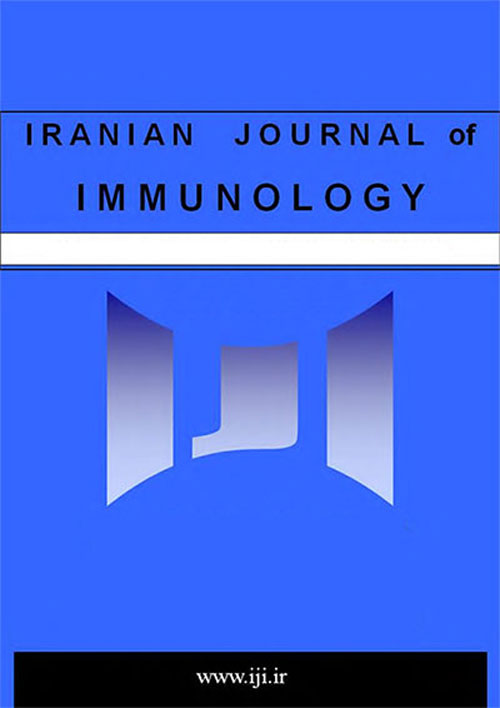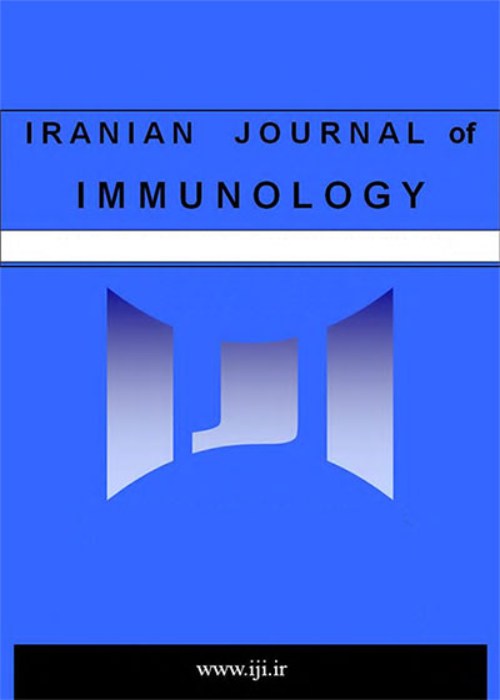فهرست مطالب

Iranian journal of immunology
Volume:14 Issue: 1, Winter 2017
- تاریخ انتشار: 1396/01/26
- تعداد عناوین: 8
-
-
The Effect of Monophosphoryl Lipid A on Maturation of DCs from Patients with Acute Myeloid LeukaemiaPages 1-12BackgroundGeneration of monocyte-derived dendritic cells (MDDC) is induced in the presence of GM-CSF and IL-4, and a maturation stimulus is added to the monocyte culture to obtain mature Dendritic Cells (DCs) suitable for therapy. TNF-α is the most common cytokine used for activating DCs and generating mature MDDC either alone or in combination with other cytokines.ObjectiveTo compare effects of traditional cytokine cocktail (TNF-α IL-1β) versus TLR4-agonist monophosphoryl lipid A on the viability, phenotype, cytokine profile and functionality of MDDC.MethodsThe study included 32 individuals; twenty Acute Myeloid Leukaemia (AML) cases in complete remission and 12 healthy volunteers. They were divided into 3 groups: Group 1: control group: 12 subjects to measure the baseline levels of all markers in the monocytic preparation. Group 2: cytokine cocktail (TNF-α) group, which included 10 AML subjects. Group 3: MPLA group which included 10 AML subjects.ResultsTNF-α group showed higher expression of CD83 than MPLA group indicating higher capacity to induce DC maturation but both were similar in CD86, CCR7 and IL-10 expression. Preparation of dendritic cells from AML cases in remission and loading them with tumor peptides was successful.ConclusionMPLA effect in DC maturation is comparable with traditional DC maturation cocktail.Keywords: DCs Maturation, Monocyte-Derived DCs
-
Pages 13-23BackgroundMesenchymal stem cells (MSCs) and transforming growth factor-β1 (TGF-β1) molecules are well known for their immunomodulatory properties and their function in tissue regeneration and remodeling.ObjectivesTo evaluate the interaction of TGF-β1 engineered MSCs with T cells and dendritic cells (DCs) and their modulatory effect on the immune response.MethodsMSCs and DCs were generated frombone marrowof Balb/c mice and T cells were generated from mice lymph nodes. TGF-β1 expressing lentiviruses were used for MSCs transduction, and then these engineered MSCs were co-cultured with T cells and DCs. T cells proliferation and cytokines release and also DCs maturation, TNF-α release, and stimulation of allogeneic T cells were evaluated.ResultsT cells proliferation and IFN-γ release were suppressed by TGF-β1/MSCs while IL-4 secretion was enhanced. Co-cultured DCs with TGFβ1/MSCs showed reduced expression of CD40, CD86, and MHC II and also lower level of TNF-α secretion. Co-cultured DCs could also induce lower levels of allogeneic T cells proliferation and IFN-γ release in comparison to control DCs.ConclusionEngineered TGF-β1/MSC cells showed collaborative immune suppressive functions between TGF-β1 and MSCs to modulate T cells and DCs immune responses. We therefore suggest that TGF-β1/MSC cells could provide a promising tool for treatment of clinical conditions such as organ transplantation, GVHD, and autoimmune disorders.Keywords: Dendritic Cells, Immunomodulation, Mesenchymal Stem Cells, Transforming Growth Factor-?1, T Cells
-
Pages 24-34BackgroundThe incidence of ischemic reperfusion injury (IRI) in early phase posttransplantation and activation of toll-like receptor (TLR-2) and TLR-4 remarkably impact the outcome of a renal allograft.ObjectiveTo investigate whether the expression of TLRs in peripheral blood mononuclear cells (PBMCs) can predict the clinical outcome of kidney allografts.MethodsWe obtained blood samples from 52 renal transplant patients before transplant, and 2, 90, and 180 days post-transplantation in order to analyze the surface expressions of TLR-2 and TLR-4 on peripheral blood monocytes. The expression patterns of TLR-2 and TLR-4 were compared between patients with graft dysfunction (GD) and those with well-functioning graft (WFG).ResultsSignificantly different mean dynamic changes in surface expression of TLR-2 according to percentage of TLR-2 cells between (the GD and WFG) groups existed at most time-points before and after renal transplantation (p=0.007) with the exception of day 2 post-transplantation. We observed significantly higher mean fluorescence intensities of TLR-2 and TLR-4 on CD14 cells in the GD group compared to the WFG group. This finding was particularly observed 180 days post-transplantation (p=0.001). Based on TLR-2 and TLR-4 protein expression for each step, multiple logistic regression and ROC curve analysis revealed that an increase in CD14 TLR-2 monocytes within the 90 days post-transplantaton was associated with increased risk of GD at 180 and 365 days post-transplantation [odds ratio (OR)=1.27, p=0.005)].ConclusionSequential monitoring of TLR-2 and TLR-4 expression patterns in peripheral blood monocytes appear to be prognostic and predictive biomarkers for early and late kidney allograft outcomes.Keywords: Allograft Function, Kidney Transplant, Toll-Like Receptors
-
Pages 35-50BackgroundDespite advances toward an improved understanding of the evasive mechanisms leading to the establishment of cystic echinococcosis, the discovery of specific immunosuppressive mechanisms and related factors are of great interest in the development of an immunotherapeutic approach.ObjectiveTo elucidate immunosuppressive effects of bioactive factors contained in chromatographic fractions from hydatid cystic fluid (HCF) of Echinococcus granulosus.MethodsHydatid cystic fluid was fractionated by reverse phase chromatography. Non-specific Concanavalin Adriven proliferation of spleen cells was used to determine specific inhibitory fractions. Trypan blue exclusion test and flowcytometry analysis were performed to check whether highly inhibitory fractions of HCF have apoptotic effect on peritoneal macrophages. Western blot analysis was used to determine proteolytic effects of parasitic antigens on major histocompatibility complex (MHC) class II (I-a) contained in membrane proteins extract from macrophages.ResultsHigh concentrations of HCF and few of chromatographic fractions suppressed spleen cells proliferation. Fractions 7 and 35 were the highest inhibitory fractions. Specifically fraction 35 and to a lesser extent HCF induced apoptosis in peritoneal naive macrophages. However, HCF and the fraction 7 proteolytically altered the expression of MHC class II molecules on peritoneal macrophages. The proteolytic molecule was identified to be a serine protease. Macrophages taken at the chronic and end phase from cystic echinococcosis-infected mice were able to uptake and process C-Ovalbumine-FITC. These cells expressed a drastically reduced level of (I-a) molecules.ConclusionOur study present new aspects of immune suppression function of E. granulosus. Further molecular characterization of apoptotic and proteolytic factors might be useful to develop immunotherapeutic procedure to break down their inhibitory effects.Keywords: Cystic Antigens, Echinococcusgranulosus, Immunosuppression, Reverse Phase Chromatography
-
Pages 51-58BackgroundCytokines are suggested to play a role in periodontitis.ObjectiveTo determine and compare the levels of Interleukin-1 beta (IL-1β) and Tumor necrosis factor alpha (TNF-α) in gingival crevicular fluid (GCF) samples amongst healthy individuals and those with chronic periodontitis. Further to compare the GCF cytokine levels in three genotype classes defined by the respective gene polymorphisms.MethodsThe study was conducted on 41 chronic periodontitis patients and 40 healthy volunteers. IL-1β and TNF-α were quantified in GCF by cytometric bead array. DNA was extracted from peripheral blood samples and genotyping of IL1B �砋 (rs1143634) IL1B -511G/A (rs16944), TNFA -1031T/C (rs1799964) and TNFA 863C/A (rs1800630) polymorphisms were performed using Sanger sequencing and Taqman SNP genotyping assays methods.ResultsBoth IL-1β and TNF-α levels were significantly higher in chronic periodontitis group compared to the controls. IL-1β and TNF-α levels did not significantly differ in genotype classes of the respective polymorphism (IL1B -511G/A, TNFA -1031T/C and TNFA -863C/A). However, individuals with CT genotype of IL1B �砋 showed higher levels of IL-1β in the gingival crevicular fluid (ANOVA pConclusionThe results of this study revealed the presence of higher levels of IL-1β and TNF-α in subjects with periodontitis and genetic control of IL-1β levels in our samples of Indians.Keywords: Gene, Gingival Crevicular Fluid, Interleukin-1 beta, Polymorphism, Allele, Tumor Necrosis Factor- alpha
-
Pages 59-72BackgroundInterleukin (IL)-23 has an important role in tumor immune regulation. The aim of the present study is to investigate the possible association of interleukin-23 receptor (IL23R) gene variants rs1884444, rs10889677and rs11209026 with development of acute lymphoblastic leukemia (ALL).MethodsThe IL23R variants were studied in 164 ALL patients and compared to 175 healthy controls by polymerase chain reactionrestriction fragment length polymorphism. The relationship between these variants and clinical and laboratory features of the patients and response to therapy were evaluated.ResultsNo significant differencesin genotype and allelefrequenciesexisted between patients and controls. The rs1884444TG genotype was significantly lower in patients who relapsed (24.2%) compared to those without relapse (55.9%, p=0.006).Fewer patients who relapsed had evidence of the G allele (P=0.034). The TG genotype was associated with a longer complete remission at 1804±116 days compared to other genotypes (100×103 μL (68.4% and 52.4%, respectively).ConclusionOur findings showed a lack of association of the studied polymorphisms with the risk of ALL. The influence of the rs1884444 polymorphism on relapse rate and association of rs10889677 AA genotype with favorable prognostic factors suggest the influence of the studied polymorphisms on ALL response to therapy and prognosis.Keywords: Acute Lymphoblastic Leukemia, Interleukin-23 Receptor, Polymorphism
-
Pages 73-80BackgroundAsthma is the chronic inflammation of airways characterized by eosinophilic infiltration, mucus overproduction, airway hyper-responsiveness and airway remodeling. These changes are induced mostly by cytokines which are produced by T helper (Th) 2 cells. Recently, the role of interleukin-23 (IL-23) in the pathogenesis of adult allergic asthma has been studied.ObjectiveTo explore IL-23 serum levels and its expression in persistent asthma compared with healthy children younger than five years old.MethodBlood samples of 40 children with mild and severe persistent asthma were compared to 34 healthy children regarding IL-23 serum levels and gene expression using enzyme-linked immunosorbentassay (ELISA) and real time quantitative polymerase chain reaction (PCR).ResultsThe IL-23 gene expression level was significantly different in the 25 children with mild persistent asthma and the 15 children with severe persistent asthma compared to the control group (p=0.001). There was no significant difference in IL-23 gene expression level between the two groups of patients with mild and severe persistent asthma. A significant difference was seen in IL23 serum levels between the 25 children with persistent asthma and control group (p=0.002).ConclusionFor pre-school children with history and physical exam in favor of asthma which cannot be tested by spirometry, IL-23 serum levels may be an auxiliary biomarker for the diagnosis of asthma.Keywords: Asthma, Childhood, Interleukin-23
-
Pages 81-88BackgroundA clear association between allergy and nasal polyposis (NP) is not determined and the role of food intolerance in patients with NP is not investigated by oral food challenge (OFC).ObjectiveTo investigate the relation of salicylate food intolerance and atopy in patients with NP according to recurrence and aspirin sensitivity.MethodsA cross sectional multicenter study was done in two tertiary centers for allergy in Iran. Adult patients with NP were selected for the study that had been referred to allergy clinics. The oral aspirin challenge (OAC) test was performed to identify aspirin exacerbated respiratory disease (AERD) and the OFC test was used to investigate food intolerance. Atopic evaluation was performed by skin-prick tests, nasal smear and blood eosinophil count as well as serum total IgE.ResultOne hundred and nineteen Iranian patients (female to male ratio 1.05) with NP were enrolled (mean age, 38 ± 11 years). Recurrence of nasal polyposis was 64.7%. OAC was performed in all cases; 43.79% cases had aspirin hypersensitivity. In addition, OFC tests determined that 69.9% of patients had salicylate food allergy. Salicylate food intolerance was significantly higher in NP cases with AERD than in aspirin tolerant patients (pConclusionAtopy and NSAID exacerbated respiratory disease; therefore, they can both be considered as predictors of NP recurrence. Our study also showed that salicylate food intolerance was associated with AERD in nasal polyposis.Keywords: nasal polyposis, food allergy, aspirin hypersensitivity, recurrence, Salicylate


